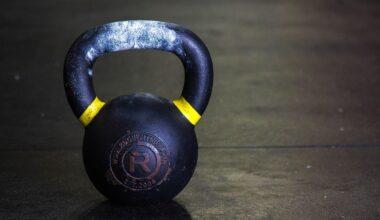Basic Landing Techniques to Prevent Injuries in Parkour
Parkour challenging yet rewarding discipline focuses on overcoming obstacles efficiently. As newcomers embark on this exhilarating journey, mastering basic landing techniques is paramount for preventing injuries. An effective landing absorbs impact, enabling smoother transitions between movements. First, one must learn to land softly. This requires bending the knees upon contact with the ground, which cushions the landing. Additionally, utilizing the balls of the feet instead of the heels helps reduce impact strain. This technique allows for better body control while maintaining agility. Equally important is landing with both feet simultaneously whenever possible; this distributes weight evenly and lowers the risk of injury. Finally, practicing landing in various environments can significantly enhance adaptability. Indoor spaces, outdoor arenas, and urban settings all present unique challenges. One must frequently adapt to diverse surfaces to develop confidence and proficiency. Developing muscle memory through repetition and conscious practice is key to success in parkour. Remember, safety should always be the first priority. Building a solid foundation through effective landing techniques not only keeps you injury-free but also elevates performance levels over time.
Next, let’s explore the three key techniques to optimize your landing experience. First, the “Roll to Absorb” technique involves tucking and rolling upon landing, thereby dispersing energy throughout your body. Doing so minimizes impact on your joints, especially the knees. Start by practicing the roll on grassy surfaces or padded mats to ensure safety. Progressively, try to incorporate this technique from trickier heights as confidence grows. Second, the “Shallow Landing” approach focuses on soft landings from lower heights without falling into a full squat. When approaching the ground, engage your core and place your feet parallel to each other. Lastly, the “Comprehensive Feedback” method involves regularly analyzing your landings. Record videos of your attempts during training sessions. Observing yourself can reveal areas needing improvement. Share the footage with fellow parkour enthusiasts to receive constructive criticism. Embrace feedback as a valuable tool that shapes your growth. Don’t forget to appreciate each milestone achieved, no matter how small. Celebrate progress and take time to rest; parkour requires both physical and mental commitment. Ultimately, effective landing techniques can significantly enhance your parkour skills while reducing the risk of injuries.
The various types of surfaces you land on impact your technique. For instance, landing on grass, foam, or sand is more forgiving than on concrete. It’s crucial to adapt your landing technique according to the surface type. Always practice on various terrains to identify the best landing strategies for each. Practicing on softer surfaces first helps build confidence. As you progress, transition to harder surfaces. Use the knowledge gained from earlier training to adapt to these challenges. For example, if practicing a jump to a concrete surface, be mindful of your technique. Prioritize a strong knee bend and foot placement to ensure a safe landing. Utilize the environment around you, taking advantage of parkour spots that yield diverse terrain. Learn which surfaces are best suited for specific maneuvers. Every session spent practicing landing techniques enhances performance. Gradually increasing difficulty levels translates into increased comfort and skill acquisition. In parkour, success derives from growth and an intrinsic motivation to improve. Combine all aspects of training—physical conditioning, technical execution, and environmental adaptability—and watch your abilities and confidence soar.
Incorporating Vision and Awareness
A crucial aspect of effective landing is the integration of vision and awareness while executing tricks. Always approach obstacles with a clear plan. Your mental visualization of the landing spot minimizes hesitation and helps you execute moves with precision. Before even jumping, assess the surrounding area and possible landing zones. Recognizing the ideal point to land reduces the risk of misjudgment and maintains balance. Train your peripheral vision to heighten awareness during jumps. This skill enhances one’s ability to quickly adapt mid-air. As you gain experience, practice maintaining focus on your identified landing zones. Develop mental habits to consistently evaluate challenges that may arise. Remember the importance of staying grounded even as you master more complex movements. Regularly working on enhancing hand-eye coordination will only benefit your overall performance. Constantly rehearse basic maneuvers in a variety of situations; even classical drills ensure that muscle memory reinforces the lessons learned during parkour sessions. Keeping your eyes focused on your landing spot makes all the difference when executing advanced parkour techniques. As they say in parkour, “the mind leads the body;” so nurture a well-prepared mental state.
Safety equipment plays a significant role in your parkour training sessions. While the essence of parkour lies in free movement and agility, protective gear such as pads or helmets can offer additional security while practicing. Remember, even seasoned practitioners benefit from the added layer of protection. Knee and elbow pads protect the joints when landing or rolling. They minimize the risk of abrasions and injuries during practice sessions. As you advance, consider investing in quality footwear designed for parkour. Proper shoes enhance grip and provide support, ensuring minimal impact on your feet during landings. Additionally, wearing breathable and flexible clothing allows for optimal movement and comfort. Avoid restrictive materials that can hinder performance. If you are training in rather challenging environments, consider additional safety measures such as seeking out padded areas or establishing a safe landing zone. Train under supervised or experienced practitioners and encourage a supportive community atmosphere. Developing a safety-first mindset fosters growth while prioritizing injury prevention. Create a reliable checklist of gear and wear it consistently to promote safer training habits as your parkour practice progresses.
Warm-Up and Cool Down Exercises
Incorporating proper warm-up and cool-down exercises into your routine supports landing techniques. Before diving into intense training, dedicate time to warming up muscles. Effective warm-ups not only boost flexibility but also reduce the risk of injuries. Dynamic stretches like leg swings or arm circles improve overall mobility. Always include a variety of exercise types that target joints and large muscle groups. After training, performing cool-down routines is equally crucial. When engaging in parkour, muscle recovery is paramount. Include static stretches to promote flexibility and enhance the range of motion. A combination of yoga or gymnastics movements effectively aids recovery. Addressing muscle tightness contributes to better landings; elicit smooth movements instead of tight, anxious landings. Successful landings are the result of relaxed muscles and bodies that respond well to different demands. Analyze your warm-up and cool-down routine to ensure a thorough approach. Approach every session with both focus and intent. The quality of warm-ups and cool-downs can significantly impact performance levels. Remember, invest time in these critical aspects of training to encourage a satisfying parkour experience with fewer injuries.
In conclusion, mastering landing techniques is the key to becoming proficient in parkour while preventing injuries. Focus on absorbing impact, utilizing the appropriate surface techniques, and fostering a strong mental approach. Consistently practice these landing skills to solidify your foundation. Assess your environment and adjust techniques accordingly. Embrace feedback from others and be open to constructive criticism to enhance your performance. Prioritize maintaining a safety-first mindset through proper gear and awareness. Engage in warm-up and cool-down exercises to ensure muscle readiness throughout your training sessions. As you progress into more advanced parkour maneuvers, keep safety and technique at the forefront of your priorities. Remember to celebrate all achievements along the journey, regardless of size. With dedication and continuous effort, you will improve your parkour skills greatly. Enjoy the process, and share your passion for parkour with others to create a supportive community. By mastering these essential landing techniques, you can navigate obstacles with confidence, ensuring a fulfilling parkour experience. Ultimately, the practice of landing techniques will allow you to pursue your parkour aspirations while remaining injury-free. So, step into your journey and jump with joy.
This is another paragraph with exactly 190 words.


